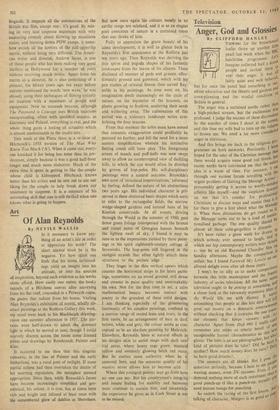Art
Of Alan Reynolds
By NEVILE WALLIS
Is it necessary to know any- thing of an artist's life in order to appreciate his work? The short answer must be in the negative. Yet how often one finds that his home surround- ings yield an insight into his attitude, or into his sources of inspiration, beyond such evidence as his works alone afford. How easily one enters the bosky tunnels of a Hitchens canvas after surveying from his flat roof, concealed in a Petworth copse, the glades that radiate from his house. Visiting Alan Reynolds's exhibition of recent, wholly ab- stract paintings at the Redfern Gallery this week, my mind went back to his Blackheath drawing- room one summer afternoon in 1957. The cur- tains were half-drawn to admit the dimmest light in which he moved at ease, though I could scarcely discern across the room some framed prints and drawings by Rembrandt, Palmer and Klee.
It occurred to me then that this singular romantic, in the line of Palmer and the early Sutherland, was a rural poet of twilight. If some partial eclipse had then overtaken the dazzle of his morning reputation, the metaphor seemed appropriate. Since then, while Reynolds's forms have become increasingly simplified and geo- metrical, his colour, it is true, has at times been rich and bright and infused at least once with the remembered glow of dahlias at Shoreham.
But now once again his colours mostly in an earthy range are subdued, and it is as an elegiac poet conscious of nature in a curtained room that one thinks of him.
Fully to appreciate the grave beauty of his latest development, it is well to glance back to Reynolds's first appearance at the Redfern just ten years ago. Then Reynolds was deriving the thin spires and pagoda shapes of his fantastic landscapes from the leaves of his albums. These disclosed all manner of pods and grasses, affec- tionately pressed and gummed, which with his pen studies of oriental finesse then served Rey- nolds in his paintings. As time went on, his imagination dwelt increasingly on the cycle of nature, on the mysteries of the heavens, on plants growing to fruition, scattering their seeds and withering away. The culmination of this period was a visionary landscape series sym- bolising the four seasons.
From that moment the artist must have sensed that romantic exaggeration could profitably be pursued no further, and felt the need for a more austere simplification wherein his instinctive feeling could still have play. The foreground screen of teasels and puff-balls was now swept away to allow an uninterrupted view of darkling hills, to which the eye would often be directed by groves of hop-poles. His self-disciplinary paintings were a natural outcome. Reynolds's own term of 'structural improvisations,' informed by feeling, defined the nature of his abstractions two years ago. His individual character is pre- served in these shuttered basic shapes which seem to refer to the rectangular fields, the narrow wedge-shaped gardens and natural hues of his Kentish countryside. At all events, driving through the Weald in the summer of 1960, past dense green foliage interspersed with the bronze and russet notes of Georgian houses beneath the lightest vault of sky, I found it easy to tune-in to the impressions yielded by these paint- ings in his spick eighteenth-century cottage at Sevenoaks. The hop-poles still lingered in the vestigial strands that often lightly attach these structures to the picture edge.
They linger in the thin vertical spears which counter the horizontal strips in his latest paint- ings, sometimes on an ovoid ground, still dense and creamy in paint quality and unmistakably his own. Not for the first time in art, a calm mathematical beauty becomes instinct with poetry in the grandest of these solid designs. I am thinking especially of the glimmering luminosity of his simplest paintings, confined to a narrow range of muted hues and ivory, in the first room. In an arrangement of bars in dark brown, white and grey, the colour seems as con- ceptual as in an absolute painting by Malevich. Elsewhere, Reynolds hints at natural effects in his designs akin to aerial maps with dark ceni tral areas, where heavy sage green, mustard yellow and sombrely glowing brick red recur; But he carries most authority when he is austerest here, and the sensuous quality of his matiere never allows him to become arid.
Where this youngish painter may go from here no one can say. But his countryman's integrity and innate feeling for stability and harmony must continue to sustain him, and meanwhile the experience he gives us in Cork Street is not to be missed.






































 Previous page
Previous page